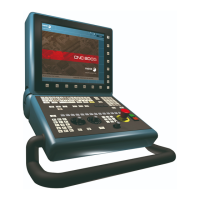Operating manual.
CNC 8060
CNC 8065
6.
MANUAL (JOG) MODE. TOOL CALIBRATION
·132·
(REF: 1807)
Probe selection
Two probes may be configured at the CNC. The probe active at the time is used for calibration.
The active probe may be changed via part-program or MDI using the instruction
#SELECT PROBE.
Geometrical configuration of the axes on a lathe: "plane" or
"trihedron".
At the lathe model, the geometrical configuration of the axes may be either of the "plane"
or "trihedron" type depending on the availability of a third main axis, usually the ·Y· axis. The
different calibration modes adapt to the current configuration showing the necessary data
for each one of them.
Configuration of "plane" type axes. The longitudinal axis.
In this configuration, the second axis of the channel is considered as longitudinal axis. If the
X (first) and Z (second) axes have been defined, the work plane will be the ZX and Z will be
the longitudinal axis. Tool length compensation is applied on this longitudinal axis when using
milling tools. With lathe tools, tool length compensation is applied on all the axes where a
tool offset has been defined.
When using milling tools on a lathe, the longitudinal compensation axis may be changed by
means of the #TOOL AX instruction or the G20 function.
#SELECT PROBE [1]
Selects the first probe.
#SELECT PROBE [2]
Selects the second probe.
Geometrical configuration of "trihedron" type axes.
It is the typical configuration of a milling machine or of a lathe
that has a third main axis (·Y· axis).
There are three axes forming a Cartesian XYZ type trihedron
like on a milling machine. There may be more axes besides
those forming the trihedron.
With this configuration, the planes behave in the same way as
on a milling machine except that the usual work plane will be
G18 (if it has been configured like that).
Geometrical configuration of "plane" type axes.
It is the typical configuration of a lathe.
There are two axes forming the usual work plane. There may
be more axes, but they cannot be part of the trihedron; there
must be auxiliary, rotary, etc.
With this configuration, the active plane will be formed by the
first two axes defined in the channel. If the X (first) and Z
(second) axes have been defined, the work plane will be the ZX
(Z as abscissa and X as ordinate).
The work plane is always G18; the plane cannot be changed
via part-program.

